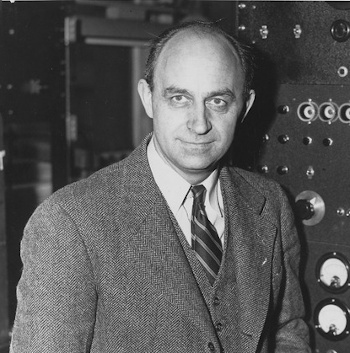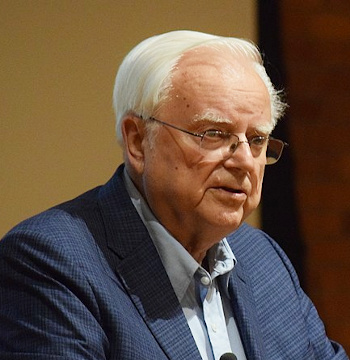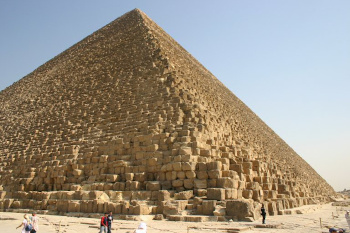Educated Guessing
December 7, 2020
Knowledge comes from
experiment, but the results of most experiments are not as definitive as one would like. While most
physical scientists are able to control their experiments quite closely, and
chemists will choose
pure materials for their
reactions, there are
oservational errors and
instrument calibration errors, and
variation in
room temperature and pressure, and
humidity from one day to another.
Likewise, experiments in many of the
life sciences are conducted on
organisms that are not precisely equivalent from one individual to another. Fortunately, the powerful
analysis tools of
statistics and
regression analysis can coax a reasonable result from experimental
data.
Statistical analysis benefits from many observations, since the
deviation from the mean value scales as the
square root of the number of measured values, so experiments benefit from multiple trials.
Statistics has allowed science to extract knowledge from data, but it has also been used to extract knowledge from
opinion, as demonstrated in 1906 by the
Victorian polymath,
Francis Galton (1822-1911).[1] Galton
observed a contest at a
livestock fair in which 787 visitors guessed the
weight of a particular
ox.[2]
People in attendance at a livestock fair a hundred years ago would have had a reasonable knowledge of the weight of oxen, but they would be unlikely to guess the exact weight. While there was a wide
range of
estimates, the
mean of the 787 guesses, 1197
pounds, was within a pound of the actual weight of 1,198 pounds; that is, the mean was within 0.1% of the actual value.[2] This
phenomenon is called the "
Wisdom of the Crowd."
.png)
A fat, 3 year old heifer, shown in an etching by T. Hatton.
While Galton's ox was a hefty 1,198 pounds, the average weight of cattle in the United States is presently about 1370 pounds.[3]
(Wellcome Trust image V0021653 (modified), via Wikimedia Commons
Statistics are not
robust against bad data, so scientists take great care in designing experiments that give data relatively free from interfering
variables. Some will do
computer modeling to determine that things are controlled enough to produce good data, but everything usually starts with some
back-of-the-envelope calculations. One of the most common of these in
solid state physics is
calculating what
vacuum pressure is required in a
chamber to prevent
contamination of a cooled
surface with
gas molecules over the course of an experiment. If you can't achieve that requirement, you shouldn't even attempt your experiment.
Scientists sometimes venture out of their
laboratories, but they use their ability to do quick back-of-the-envelope calculations to make educated guesses about things in the outside world. A master of this was 1938
Physics Nobel Laureate,
Enrico Fermi (1901-1954), who was famous for posing, and also solving, what are called "
Fermi problems." These are estimates of unusual quantities based on whatever
information is at hand.

Enrico Fermi (1901-1954 at a laboratory control panel, sometime between 1943 and 1949.
Chemical element 100, Fermium (Fm), is named in his honor. It was discovered in 1952 at Lawrence Berkeley National Laboratory while Fermi was still living, although not officially called Fermium at the time.
There's an amazingly long list of things named after Fermi.
(Portion of a Wikimedia Commons image from the National Archives and Records Administration, NAID 558578.)
One example of a Fermi problem that I described in an
earlier article (Estimation, December 21, 2011) is his calculation of the number of
piano tuners in
Chicago. This estimate involves quantities such as the fraction of
households that have
pianos (many more at the time of the calculation than today), how often they are tuned, and how long it takes to tune a piano. I would often make similar estimates, such as the
population of our
county, based on the number of
supermarkets.
Another example was Fermi's estimate of the
yield from the
Trinity nuclear test. This was the first
detonation of a
nuclear weapon. Years earlier,
Edward Teller (1908-2003) had the idea that this detonation might cause a
runaway fusion of
atmospheric nitrogen; that is, set the atmosphere on fire and destroy
life on Earth.[4]
Hans Bethe (1906-2005) did a calculation that showed that this was impossible. Fermi, probably to relieve the
psychological stress at Trinity, proposed
bets on whether this would happen.[4] Fermi's yield test was based on how far pieces of
paper were
blown by the
pressure wave of the blast. His back-of-the-envelope calculation, which in this case may have actually involved a shredded
envelope as the source of the bits of paper, gave a value about half the actual value of 22
kilotons of TNT.
Perhaps the most adventuresome of such calculations is the
Drake equation that estimates the number of detectable
extraterrestrial civilizations in our
Milky Way galaxy. This 1961 equation by
radio astronomer,
Frank Drake (b. 1930), has seven estimated quantities that are
multiplied together to give the number of such civilizations. While the
logic behind this equation is sensible, the
uncertainty in these seven terms is such that the equation leads to a wide range of possible values.

Radio astronomer Frank Drake speaking at Cornell University (Ithaca, New York), October 19, 2017.
Drake and Carl Sagan (1934-1996) designed the Pioneer plaque in 1972. This plaque was designed to provide information about Earth and its inhabitants to any extraterrestrials who might discover the spacecraft.
Drake also supervised creation of the Voyager Golden Record, a more elaborate message than the Pioneer plaque.
(Portion of a Wikimedia Commons image by Amalex5.)
A back-of-the-envelope calculation of the number of
workers involved in the
construction of the
Great Pyramid of Giza, was presented by
Vaclav Smil in a recent issue of
IEEE Spectrum.[5] This pyramid, built in a period of 10-20 years around 2560
BC, was created from 2,500,000
cubic meters (91,000,000
cubic feet) of
limestone and
granite. Using some basic
physics, Smil estimates that the number of workers involved was far fewer than commonly believed.
The only
historical account of the number of workers was that of the
Greek historian,
Herodotus (484- c.425 BC), who wrote about the topic about two
millennia after the fact in
The Histories.[6] In 1974,
physicist,
Kurt Mendelssohn, estimated a labor force of 70,000
seasonal workers with perhaps as many as 10,000 permanent
masons.[5] Smil's estimate from some
first principles thermodynamics yields a much smaller workforce.

The portion of The Histories (Book 2, Section 120, Euterpe) by Herodotus describing the workforce for building the Great Pyramid of Giza. It reads in translation that "A hundred thousand men laboured constantly, and were relieved every three months by a fresh lot." (Greek text and translation from Sacred Texts.[7])
Smil considers the
potential energy required to lift all that stonework to its proper level, a simple calculation involving
gravitational acceleration, the
density of the
stone (about 2.6
g/cc), and the
center of mass of the pyramid, which is at one-quarter its height.[5] He balances this energy (about 2.4 trillion
joules) against the useful
work that can be extracted from the
basal metabolic rate of a
human (about 450 kilojoules a day).[5]
This gives 5.3 million
man-days for raising the pyramid, or about 18,000
man-years. If the construction took 20 years, the workforce to raise the pyramid is only about 900 men.[5] Others would have been needed to
quarry the stone, move it into place, oversee the details of construction, and provide other support functions. Smil's total estimate is fewer than 7,000 workers, an
order of magnitude fewer than previously thought.[5]

The Great Pyramid of Giza of one of the Seven Wonders of the Ancient World, a list that included the Statue of Zeus at Olympia and the Lighthouse of Alexandria.
The list also included the Hanging Gardens of Babylon, the existence of which is disputed. They are not mentioned in any extant Babylonian manuscripts, and there is no archaeological evidence for their existence. This is quite unexpected, since the gardens were supposedly created nearly 2,000 years after the Great Pyramid of Giza.
(Wikimedia Commons image by Alex lbh)
I've done my own calculation of an historical event by calculating the number of
warriors who fought in the
Trojan War, the best record of which is
Homer's Iliad. The
Catalog of Ships in Book II of the Iliad lists 1186 ships. The Greek
troop transport of that era had 22 rows of paired
oarsmen, for 44 men per ship. This gives 52,184 men. We could give allowances for the
nobility, who likely did not row, to round this up to about 53,000. Some
scholars have inflated this figure upwards to 100,000-135,000, but I believe they were using the plan of a much later Greek warship that held more men.
It appears that the
Trojans were outnumbered more than 10:1, as indicated in Book II, ll. 125-134, which in
Alexander Pope's translation reads,
"So small their number, that if wars were ceased,
And Greece triumphant held a general feast,
All rank'd by tens, whole decades when they dine
Must want a Trojan slave to pour the wine."
This means that if there were Trojans assigned to pour
wine for groups of ten Greeks, there would be some Greeks without a
server. Some of these servers would have been
women, so there may have been perhaps 3,000 Trojan warriors. This leads to my estimate of the number of warriors in the Trojan War as 53,000 + 3,000 = 56,000.
References:
- Francis Galton, "Vox Populi," Nature, vol. 75, no. 1949 (March 1, 1907), pp. 450-451, https://doi.org/10.1038/075450a0.
- Graham Kendall, "How to unleash the wisdom of crowds," The Conversation, February 9, 2016.
- Cattle: Commercial Slaughter Average Liveweight by Month and Year, US, United States Department of Agriculture, National Agricultural Statistics Service.
- John Horgan , "Bethe, Teller, Trinity and the End of Earth," Scientific American, August 4, 2015.
- Vaclav Smil, "How Many People Did it Take to Build the Great Pyramid?" IEEE Spectrum, May 27, 2020. A PDF file of this article can be found here.
- Herodotus, "The History," 440 B.C.E, George Rawlinson, Trans., at the The Internet Classics Archive by Daniel C. Stevenson.
- The History of Herodotus, Greek, with English translation by G. C. Macaulay, Macmillan (New York: 1890), at sacred-texts.com.
- Homer, The Iliad, Alexander Pope, Trans., at Wikisource.
Linked Keywords:
Knowledge; experiment; physical science; physical scientist; chemist; impurity; pure; material; chemical reaction; oservational error; scientific instrument; calibration; error; coefficient of variation; standard conditions for temperature and pressure; room temperature and pressure; humidity; life sciences; organism; data analysis; statistics; regression analysis; data; statistical analysis; deviation (statistics); deviation from the mean value; proportionality (mathematics); scaling; square root; opinion; Victorian era; polymath; Francis Galton (1822-1911); crowd sourcing; contest; livestock; fair; mass; weight; ox; range (statistics); estimation; estimate; arithmetic mean; pound (mass); phenomenon; Wisdom of the Crowd; adipose tissue; fat; heifer; etching; ox; mean; average; cattle; United States; Wellcome Trust image V0021653; etching by T. Hatton; Wikimedia Commons; resilience; robust; dependent and independent variable; computer simulation; computer modeling; back-of-the-envelope calculation; solid state physics; calculation; calculating; vacuum; pressure; vacuum chamber; contamination; surface; gas molecule; laboratory; Nobel Prize in Physics; Physics Nobel Laureate; Enrico Fermi (1901-1954); Fermi problem; information; control panel (engineering); synthetic element; chemical element; Fermium (Fm); Lawrence Berkeley National Laboratory; things named after Fermi; National Archives and Records Administration; piano tuning; piano tuner; Chicago; household; piano; population; county; supermarket; nuclear weapon yield; Trinity nuclear test; detonation; nuclear weapon; Edward Teller (1908-2003); nuclear chain reaction; runaway; nuclear fusion; atmosphere of Earth; atmospheric; nitrogen; life on Earth; Hans Bethe (1906-2005); psychological stress; gambling; bet; paper; wind; blowing; P-wave; pressure wave; envelope; TNT equivalent; kilotons of TNT; Drake equation; extraterrestrial life; extraterrestrial civilizations; Milky Way galaxy; radio astronomy; radio astronomer; Frank Drake (b. 1930; product (mathematics); multiplied together; logic; uncertainty; Cornell University (Ithaca, New York); Carl Sagan (1934-1996); Pioneer plaque; information; Earth; inhabitant; spacecraft; Voyager Golden Record; laborer; worker; construction; Great Pyramid of Giza; Vaclav Smil; IEEE Spectrum; Anno Domini; BC; cubic meters; cubic feet; limestone; granite; physics; history; historical; Ancient Greece; Greek; historian; Herodotus (484- c.425 BC); millennium; millennia; The Histories; physicist; Kurt Mendelssohn; season; seasonal; stonemasonry; mason; first principles; thermodynamics; workforce; building; translation; potential energy; gravitational acceleration; density; rock (geology); stone; g/cc; center of mass; joule; work (physics); basal metabolic rate; human; man-hour; man-day; man-year; quarry; order of magnitude; Seven Wonders of the Ancient World; Statue of Zeus at Olympia; Lighthouse of Alexandria; Hanging Gardens of Babylon; extant literature; Babylonia; Babylonian; manuscript; archaeology; archaeological; warrior; Trojan War; Homer; Iliad; Catalog of Ships; troopship; troop transport; rowing; oarsmen; nobility; scholar; Troy; Trojan; Alexander Pope; translation; wine; waiting staff; server; woman; women.